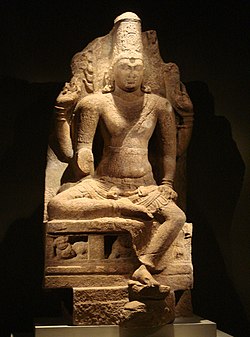Pandyan art and architecture: Difference between revisions
>Allforrous (new key for Category:Pandyan architecture: " " using HotCat) |
|||
| Line 14: | Line 14: | ||
=== Tirunelveli === | === Tirunelveli === | ||
* [[Nellaiappar Temple]] | * [[Nellaiappar Temple]] | ||
| Line 21: | Line 20: | ||
*[[Sittanavasal Cave]] - Rock cut cave and Paintings from 9th century Pandyan period | *[[Sittanavasal Cave]] - Rock cut cave and Paintings from 9th century Pandyan period | ||
*[[Srivilliputhur Andal temple]] | *[[Srivilliputhur Andal temple]] | ||
*[[Nataraja Temple, Chidambaram]] | |||
*[[Ranganathaswamy Temple, Srirangam|Ranganathaswamy Temple]] | *[[Ranganathaswamy Temple, Srirangam|Ranganathaswamy Temple]] | ||
Revision as of 22:21, 12 June 2021
Rock cut and structural temples are significant part of Pandyan art and architecture. The vimana and mandapa are some of the features of the early Pandyan temples.[1] Groups of small temples are seen at Tiruchirappalli district of Tamil Nadu. The Shiva temples have a Nandi bull sculpture in front of the maha mandapa.[2] In the later stages of Pandyas rule, finely sculptured idols, gopurams on the vimanas were developed. Gopurams are the rectangular entrance and portals of the temples.[3][4]
History

Four-armed Vishnu, Pandya Dynasty, 8th–9th century CE.
This section is empty. You can help by adding to it. (February 2019) |
Pandyan Temples
Kalugumalai Temple complex (768-800 CE)
Tirunelveli
Others
- Meenakshi Amman Temple
- Sittanavasal Cave - Rock cut cave and Paintings from 9th century Pandyan period
- Srivilliputhur Andal temple
- Nataraja Temple, Chidambaram
- Ranganathaswamy Temple

Kalugumalai Jain Beds, Pandyan Empire, King Parantaka Nedunjadaiya (768-800 CE)
References
- ↑ Desai, Pandurang Bhimarao (1971). Studies in Indian history and culture: volume presented to Dr. P. B. Desai ... on the occasion of his completing sixty years. Prof. P. B. Desai Felicitation Committee, Karnatak University; [for copies write to the printer: K. E. B's Print. Press]. p. 125.
- ↑ Rajan, K. V. Soundara (1 March 1998). Rock-cut temple styles: early Pandyan art and the Ellora shrines. Somaiya Publications. p. 58. ISBN 9788170392187.
- ↑ Allen, Margaret Prosser (1991). Ornament in Indian Architecture. University of Delaware Press. p. 350. ISBN 9780874133998.
- ↑ Mansingh, Surjit (9 May 2006). Historical Dictionary of India. Rowman & Littlefield. p. 430. ISBN 9780810865020.
- ↑ "Sthala Varalaru". Hindu Religious and Endowment Board, Government of Tamil Nadu. 2015. Archived from the original on 17 November 2015. Retrieved 4 November 2015.

